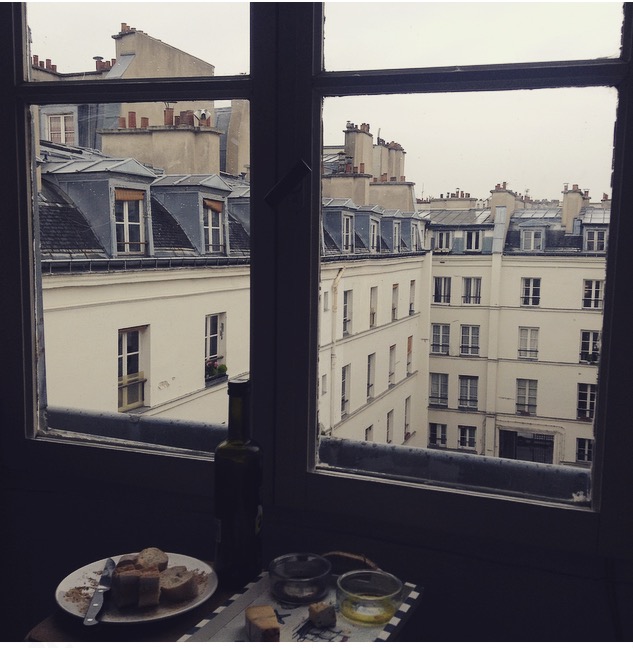Creativity: A Survival Guide
I am writing this from Paris, all bundled up by the widow sill. The apartment is tiny – Bien Sûr – but the view provides more than enough grandeur. Through rain drops on the glass I look out over the classic Parisian courtyard and a skyline populated by chimneys. Oh yeah, there might be wine and cheese involved too.
The above photo was taken on another day from another office – Monday in Krakow, Poland. It was negative 4 degrees celcius – too cold to sightsee. Plus, I had work to do, and tea to drink and a windowsill.
This is the best part of freelance work: the travel, the independence, the cheese.
A confession: sometimes it actually sucks. Creative work is hard. Freelancing is tough. Rejection is part of the job and that can be plain horrible.
I wrote this article for Career Addict about the hardest parts of creative work. It rehashes some ideas that I have already expressed on this blog, but these are the ideas that I find myself coming back to in the tough times.
The Hardest Part of Creative Work
Congratulations, you’ve chosen to work in a creative job – You are truly living what you love. Choosing to work in a creative field is a tough decision. Chances are you have gone against the grain, redefined your own ideas of success and prioritized meaning over money.
The truth is, however, making that choice is by no means the toughest part.
The Do What You Love Matra is gaining momentum. Our generation, the millennials, are re-thinking the traditional concept of work. The average person spends 80,000 hours of their life consumed by work. We are starting to figure out that the key to thriving could be a simple alchemy: mixing what we do with what we love.
What the Do What You Love philosophy neglects are hard truths of creative work. Dreams don’t work unless you do. Rejection, self-critique and inconsistency are hallmarks of life as a creative. The struggling artist is a cliche for a reason.
The good news: collaboration is key within the creative fields. There is a whole community of artists who have struggled with these same problems, and who are willing to share their secrets.
Here are some practical tips from the artistic community that will help you overcome the hardest parts of working in a creative job.
~
Change your perspective.
When you first start out as a freelancer, every rejection can feel like a blow. In his viral talk Make Good Art Neil Gaimen, a prolific author, suggests that we change our view so that rather than mourning each rejection, we celebrate each success. In his words,
‘A freelance life, a life in the arts, is sometimes like putting messages in bottles, on a desert island… you have to accept that you may put out a hundred things for every bottle that winds up coming back.’
In this case, consistency is key. Each success is worth one hundred failures.
The vulnerability that comes from rejection could work in your favor. Do you have those dreams where you are naked in public? Gaimen does, and he has something interesting to say about it. In this same speech he identified fear as a omen for something good.
“The moment that you feel, just possibly, you are walking down the street naked, exposing too much of your heart and your mind, and what exists on the inside, showing too much of yourself…That is the moment, you might be starting to get it right.”
The most important thing to take away from Gaimen’s advice is a sense of perspective: it is the way that we view rejection and vulnerability that could make all the differance is our creative career.
Don’t be Afraid to Ask for Help.
Though she is now a successful musician and writer, Amanda Palmer used to be a street performer. – a living statue called the 8 Foot Bride. In a speech called The Art of Asking, Palmer recounts how this prepared her for life in the creative arts. Busking taught her that, rather than a sign of weakness, asking for help was an ‘opportunity for random closeness’. Palmer goes on to explain that
‘Through the very act of asking people, I’d connected with them, and when you connect with them, people want to help you.’
The artist is often portrayed as a lone wolf. Palmer dismisses this idea to show that art is a tool for connection, and artists are dependent on others for help.
When you embark on your own creative career, it is important to keep this in mind: Asking for help is not a sign of defeat – it is an opportunity for collaboration,
~
When you chose to work in a creative job, you chose to prioritize your creative self: the part of you that lights up your eyes and gives your days meaning. Though creative work will be tough it will be rewarding. The good times should be worth the bad. If it comes to the point where you forget why you chose this path, take a step back. Remember: you have chosen to live what you love.
This entry was posted by in ! Без рубрики, Blog, Career, Do What You Love, Fashion, Featured, Gallery, Home, Lifestyle, Peru, Portfolio, Postcards, Quotes, Style, Travel, Travel The World, Uncategorized, Wanderlust, Wellness and tagged Creative work, Freelance tips, Freelance Work, Travel.


